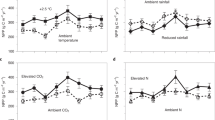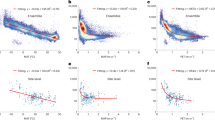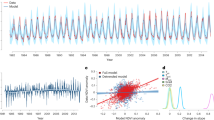Abstract
Terrestrial ecosystems and the climate system are closely coupled, particularly by cycling of carbon between vegetation, soils and the atmosphere. It has been suggested1,2 that changes in climate and in atmospheric carbon dioxide concentrations have modified the carbon cycle so as to render terrestrial ecosystems as substantial carbon sinks3,4; but direct evidence for this is very limited5,6. Changes in ecosystem carbon stocks caused by shifts between stable climate states have been evaluated7,8, but the dynamic responses of ecosystem carbon fluxes to transient climate changes are still poorly understood. Here we use a terrestrial biogeochemical model9, forced by simulations of transient climate change with a general circulation model10, to quantify the dynamic variations in ecosystem carbon fluxes induced by transient changes in atmospheric CO2 and climate from 1861 to 2070. Wepredict that these changes increase global net ecosystem production significantly, but that this response will decline as the CO2 fertilization effect becomes saturated and is diminished by changes in climatic factors. Thus terrestrial ecosystem carbon fluxes both respond to and strongly influence the atmospheric CO2 increase and climate change.
This is a preview of subscription content, access via your institution
Access options
Subscribe to this journal
Receive 51 print issues and online access
$199.00 per year
only $3.90 per issue
Buy this article
- Purchase on Springer Link
- Instant access to full article PDF
Prices may be subject to local taxes which are calculated during checkout




Similar content being viewed by others
References
Amthor, J. S. Terrestrial higher-plant response to increasing atmospheric [CO2] in relation to the global carbon cycle. Global Change Biol. 1, 243–247 (1995).
Houghton, R. A. & Woodwell, G. M. Global climatic change. Sci. Am. 260, 36–47 (1989).
Ciais, P., Tan, P. P., Trolier, M., White, J. W. C. & Francy, R. J. Alarge northern hemisphere terrestrial CO2sink indicated by 13C/12C of atmospheric CO2. Science 269, 1098–1102 (1995).
Keeling, R. F., Piper, S. C. & Heimann, M. Global and hemispheric CO2sinks deduced from changes in atmospheric O2concentration. Nature 381, 218–221 (1996).
Wofsy, S. C., Munger, J. E., Bakwin, P. S., Daube, B. C. & Moore, T. R. Net CO2uptake by northern woodlands. Science 260, 1314–1317 (1993).
Grace, J. et al. Carbon dioxide uptake by undisturbed tropical forests, 1992 and 1993. Science 270, 778–780 (1995).
Melillo, J. M. in Global Change and Terrestrial Ecosystems (eds Walker, B. & Steffen, W.) 431–450 (Cambridge Univ. Press, (1996)).
Smith, T. M. & Shugart, H. H. The transient response of terrestrial carbon storage to a perturbed climate. Nature 361, 523–526 (1993).
Cao, M. K. & Woodward, F. I. Net primary and ecosystem productions and carbon stocks of terrestrial ecosystems and their response to climate change. Global Change Biol. 4, 185–198 (1998).
Mitchell, J. F. B., Johns, T. C., Gregory, J. M. & Tett, S. F. B. Climate response to increasing levels of greenhouse gases and sulphate aerosols. Nature 376, 501–504 (1995).
Houghton, J. T., Callander, B. A. & Varney, S. K. (eds) Climate Change 1992. The Supplementary Report to the IPCC Scientific Assessment (Cambridge Univ. Press, (1992)).
Johns, T. C. et al. The second Hadley Centre coupled ocean-atmosphere GCM: model description, spinup and validation. Clim. Dyn. 13, 103–134 (1997).
Jones, P. D. Hemispheric surface air temperature variations: a reanalysis and an update to 1993. J.Clim. 7, 1794–1802 (1994).
Oechel, W. C. et al. Recent change of Arctic tundra ecosystems from a net carbon dioxide sink to a source. Nature 361, 520–523 (1993).
Townsend, A. R., Vitousek, P. M. & Holland, E. A. Tropical soils could dominate the short-term carbon cycle feedback to increased global temperature. Clim. Change 22, 293–303 (1992).
Dai, A. & Fung, I. Y. Can climate variability contribute to the “missing” CO2sink? Glob. Biogeochem. Cycles 7, 599–609 (1993).
Braswell, B. H., Schimel, D. S., Linder, E. & Moore, B. The response of global terrestrial ecosystems to interannual temperature variability. Science 278, 870–873 (1997).
Myneni, R. B., Keeling, C. D., Tucker, C. J., Asrar, G. & Nemani, R. R. Increased plant growth in the northern high latitudes from 1981 to 1991. Nature 386, 698–702 (1997).
Lloyd, J. et al. Asimple calibrated model of Amazonian rainforest productivity based on leaf biochemical properties. Plant Cell Environ. 18, 1129–1145 (1995).
Oechel, W. C., Vourlitis, G. & Hastings, S. J. Cold season CO2emission from Arctic soils. Glob. Biogeochem. Cycles 11, 151–162 (1997).
Zimov, S. A. et al. Siberian CO2efflux in winter as a CO2source and cause of seasonality in atmospheric CO2. Clim. Change 33, 111–120 (1996).
Houghton, R. A. in The Global Carbon Cycle (ed. Heimann, M.) 139–157 (Springer, New York, (1993)).
Dixon, R. K. et al. Carbon pools and flux of global forest ecosystems. Science 263, 185–190 (1994).
Melillo, J. M., Fruce, P. A., Houghton, R. A., Moore, B. & Skole, D. L. Land-use changes in the Soviet Union between 1850 and 1980: causes of a net release of CO2to the atmosphere. Tellus B 40, 116–128 (1988).
Holland, E. A. et al. Variations in the predicted spatial distribution of atmospheric nitrogen deposition and their impact on carbon uptake by terrestrial ecosystems. J. Geophys. Res. 102, 15849–15866 (1997).
Gower, S. T., McMurtrie, R. E. & Durty, D. Aboveground net primary production decline with stand age: potential causes. Trends Ecol. Evol. 11, 378–383 (1996).
McGuire, A. D., Melillo, J. M. & Joyce, L. A. The role of nitrogen in the response of forest net primary production to elevated atmospheric carbon dioxide. Annu. Rev. Ecol. Syst. 26, 473–503 (1995).
Schulze, E.-D. Flux control at the ecosystem level. Trends Ecol. Evol. 10, 40–43 (1994).
Foley, J. A. et al. An integrated biosphere model of land-surface processes, terrestrial carbon balance, and vegetation dynamics. Glob. Biogeochem. Cycles 10, 603–628 (1996).
Pitelka, L. F.et al. Plant migration and climate change. Am. Sci. 85, 464–473 (1997).
Acknowledgements
This work is being supported by the Natural Environment Research Council, UK. We thank R. Betts, the Hadley Centre for Climate Prediction and Research, UK for supplying the climatic and CO2 data, P. L. Mitchell and D. J. Beerling for their critical comments.
Author information
Authors and Affiliations
Corresponding author
Rights and permissions
About this article
Cite this article
Cao, M., Woodward, F. Dynamic responses of terrestrial ecosystem carbon cycling to global climate change. Nature 393, 249–252 (1998). https://doi.org/10.1038/30460
Received:
Accepted:
Issue Date:
DOI: https://doi.org/10.1038/30460
This article is cited by
-
Time lag effect of vegetation response to seasonal precipitation in the Mara River Basin
Ecological Processes (2023)
-
Analysing the spatio-temporal patterns of vegetation dynamics and their responses to climatic parameters in Meghalaya from 2001 to 2020
Environmental Monitoring and Assessment (2023)
-
Determining the role of richness and evenness in alpine grassland productivity across climatic and edaphic gradients
Oecologia (2022)
-
Effect of geomorphologic features and climate change on vegetation distribution in the arid hot valleys of Jinsha River, Southwest China
Journal of Mountain Science (2022)
-
Stocking rate changed the magnitude of carbon sequestration and flow within the plant-soil system of a meadow steppe ecosystem
Plant and Soil (2022)
Comments
By submitting a comment you agree to abide by our Terms and Community Guidelines. If you find something abusive or that does not comply with our terms or guidelines please flag it as inappropriate.



